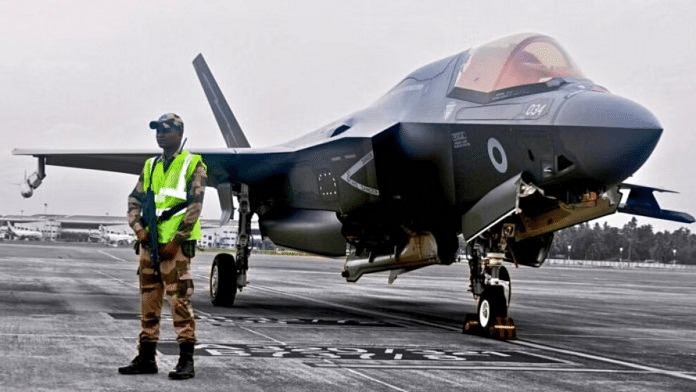New Delhi: Nearly two weeks after making an emergency landing due to a suspected hydraulic failure, the British Royal Navy F-35B Lightning II fighter jet remains grounded at the Thiruvananthapuram International Airport, guarded by the Central Industrial Security Force (CISF).
In a statement Thursday, the British High Commission said that the jet would be finally moved to a maintenance, repair and overhaul (MRO) hangar once specialist equipment and an engineering team from the UK arrive. Reportedly, a special towing vehicle, along with a 40-member team of British engineers and technical specialists, has been flown in from the UK to assess and service the grounded F-35B.
As earlier reported by ThePrint, the aircraft had been operating from the Royal Navy’s aircraft carrier HMS Prince of Wales, which had recently concluded joint exercises with the Indian Navy and was flying outside India’s Air Defence Identification Zone (ADIZ) when it was diverted to Thiruvananthapuram, designated as an emergency recovery airfield. Preliminary assessments also indicated that the aircraft may have also experienced fuel starvation during its final approach, which could have damaged components critical to its vertical landing function.
The Indian Air Force (IAF) had confirmed that the British fighter declared an emergency mid-flight and was detected and cleared for landing by the IAF’s Integrated Air Command and Control System (IACCS).
Also Read: Week since emergency landing, UK’s F-35B fighter still grounded in Kerala; military airlift likely
Maintenance woes flagged in official reviews
The F-35B is the short take-off and vertical landing (STOVL) variant of Lockheed Martin’s fifth-generation F-35 stealth fighter, with an estimated unit cost of around $110 million (approximately Rs 920 crore).
Designed for operations from aircraft carriers and amphibious assault ships, it is equipped with a swivelling engine nozzle and a shaft-driven LiftFan to enable vertical landings which depend heavily on hydraulic mechanisms. Subsequently, hydraulic failures in such platforms can impact the functioning of control surfaces, landing gear, brakes and in the case of the F-35B, its vertical lift system.
A 2024 report by the U.S. Government Accountability Office (GAO) put the average repair time for major F-35 components, including hydraulics, at 141 days, well above the programme’s initial target of 60 days. The delays were attributed to spare parts shortages, limited maintenance capacity and global supply chain bottlenecks in the report.
It also projected total lifetime sustainment costs for the F-35 programme at $1.58 trillion (Rs 132 lakh crore), up 44 percent from a 2018 estimate of $1.1 trillion (Rs 92 lakh crore), making it one of the most expensive American weapon programmes. Despite these cost and maintenance challenges, the Pentagon intends to procure around 2,500 F-35 aircraft across all three variants, with operational service expected to continue into the 2080s.
Primarily flown by the U.S. Marine Corps, the F-35B is one of the three variants in the F-35 family. The F-35A, a conventional take-off and landing model used by the U.S. Air Force and multiple allied air forces; and the F-35C, a carrier-based variant operated exclusively by the U.S. Navy. For the F-35B variant, annual sustainment costs are estimated at between $6.6 and $6.8 million (Rs 55-57 crore) per aircraft, again exceeding earlier projections.
Moreover, a report by the Director of Operational Test and Evaluation (DOT&E) within the U.S. Department of Defense, published in early 2024, flagged multiple unresolved issues in the F-35 programme, including reliability concerns, inaccuracies in the gun system and logistical burdens, particularly with the F-35B.
Despite these flagged concerns, the Department of Defense approved full-rate production of the F-35 in March 2024, just weeks after the report’s release. The American think tank Project on Government Oversight (POGO) stated that members of the U.S. Congress had limited access to the classified test findings prior to the production approval.
In another case in December 2022, the Israeli Air Force temporarily grounded 11 of its F-35 fighters following the crash of a U.S. Marine Corps F-35B in Texas earlier that year. The precautionary measure was reportedly based on guidance from the Joint Program Office to inspect aircraft that could be affected by a shared propulsion issue.
Despite scrutiny, the F-35 is widely considered the most advanced multirole combat aircraft in service today.
At the NATO Summit in The Hague on Wednesday, UK Prime Minister Keir Starmer announced that Britain would acquire at least 12 F-35A aircraft for the Royal Air Force (RAF). This would mark the RAF’s first acquisition of the conventional variant, which is certified to carry the US-built B61 nuclear bomb. The move will restore the UK’s capability for both nuclear and conventional air-launched strike missions, capabilities not held since the Cold War.
Notably, the UK was also the first country to exclusively order the F-35B variant, having placed an order for 48 aircraft. Of these, 37 have been delivered since the first aircraft arrived in 2012.
Furthermore, according to a Strategic Defence Review published by the UK Ministry of Defence earlier this month, the future of the British Lightning Force will involve a mix of F-35A and F-35B variants. The review noted that the final composition would be determined based on operational needs and cost-efficiency. While the F-35A is not carrier-compatible, it offers advantages aligned with the UK’s strategic and financial priorities.
(Edited by Tony Rai)
Also Read: MoD signs 13 contracts worth nearly Rs 2,000 crore to beef up Army’s counter-terrorism capabilities






